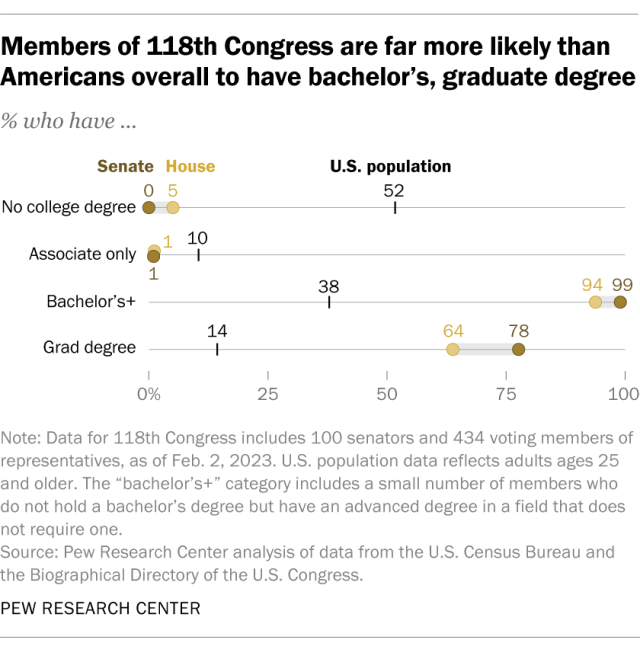How many members of the current 118th Congress do not have a college (bachelor’s) degree?
Critical Analysis
Find answers to the following questions using the visual above, any links below, your big brain, and your knowledge of American government and politics:
According to the data from the visual above, does the U.S. House or the U.S. Senate have a higher percentage of members who hold bachelor’s degrees?
According to the data from the visual above, in the 79th Congress, what percentage of Senators held bachelor’s degrees.
According to the data from the visual above, describe one trend in education levels in the U.S. Congress since 1945.
What explains that change?
Not every current lawmaker went to college. Twenty-two members of the House have only a high school diploma, according to the Congressional Research Service. That’s 6 percent of lawmakers — a significant reduction from the 1961-1962 legislative session, when nearly a quarter of lawmakers had only high school diplomas. In the Senate, Republican Markwayne Mullin of Oklahoma is the lone senator without at least a bachelor’s degree. He holds an associate degree from Oklahoma State University of Technology. Sen. Rand Paul, a Kentucky Republican, earned a doctorate in medicine from Duke University Medical School but does not hold a bachelor’s. Explain whether you would vote for a congressional candidate who did NOT have a college degree.
At the other end of the educational spectrum, about a third of House members and half of senators hold law degrees, CRS found. Our analysis shows more than 60 percent of those with a juris doctor (law) degree are Democrats, while those with a master of business administration are more likely to be Republican. Similarly, more than two-thirds of the legislators with doctorates are Democrats, but an even bigger majority of those in Congress who have medical degrees are Republicans. In the first U.S. congress, what percentage of members had college degrees?* (By the way, I don’t know the answer to this question. I am truly curious. If you put the answer in the comments section below I will be grateful.)
According to the data from the visual below*, describe one trend in education levels in the U.S. Congress since 1945.
Census Bureau data shows that most Americans over the age of 25 don’t have a four-year degree. Based on the data from the visual below*, describe the gap in educational attainment between the U.S. Congress and the general U.S. population.
Make a claim about the political consequence of the educational gap between the Congress and the rest of the nation.
Based on the data from the visual below*, make a claim about Congress members’ fields of study in college and its impact on policy.
Write and Discuss
Take ten minutes to write about the question at the top of the page and then discuss with your classmates.
Act on your Learning
Research or contact your 2 U.S. Senators and 1 U.S. House Representative to learn about their educational background. Share your findings in class or online.
Get Creative
If American education levels were a brand of cereal what brand would it be?
Learning Extension
Check out the Pew Research Center survey of education in the 118th Congress.
Get AP exam-ready with diagnostic tests, online review games, test review sheets, practice quizzes, full-length practice exam, and self-guided writing workshops. We'll make studying a breeze.





